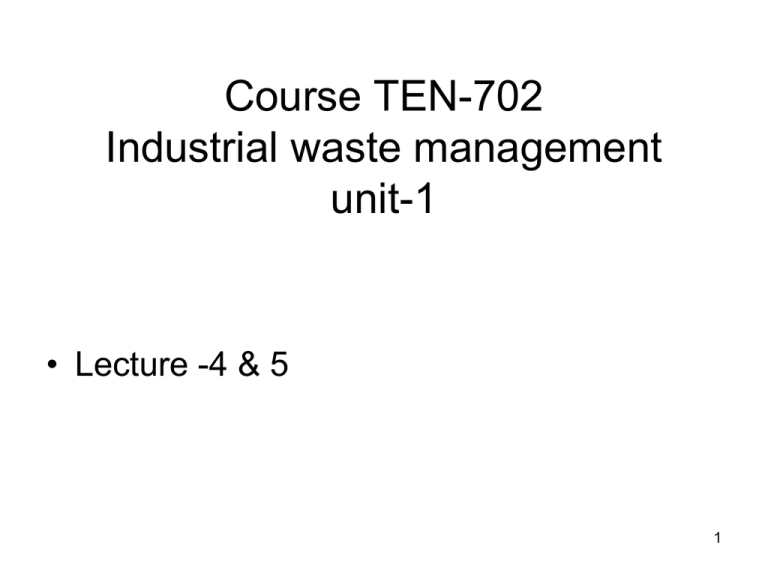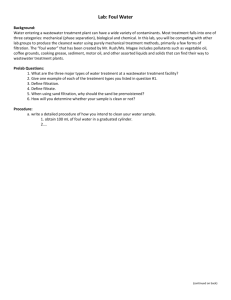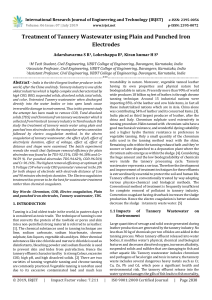Lecture-4 &5
advertisement

Course TEN-702 Industrial waste management unit-1 • Lecture -4 & 5 1 Industrial Wastewater Characteristics Characteristics are industry specific and categorized as: - Physical - Chemical - Organic - inorganic - Biological Concentrations characterize wastewater as: weak, medium, and strong. 2 Physical characteristics • • • • • • • Temperature pH Solids TS, TSS,TDS,FSS,VSS,VDS,FDS Colour Odour Taste Turbidity 3 NonSettleable Total Suspende d Solids Volatile Fixed Volatile Settleable Fixed Total Solids Total Dissolved Solids Volatile Fixed 4 Chemical Characteristics • Organic Matter – – – • • • • Biochemical Oxygen Demand (BOD5) The BOD 5 test results are used to: Chemical Oxygen Demand (COD) Fats, Oils, and Grease Surfactants. Phenols. Volatile Organic Compounds (VOCs). • Pesticides & Agricultural Chemicals. 5 Inorganic characteristics • • • • • • Inorganic Matter Alkalinity. Nitrogen Phosphorus Sulfur. Toxic Inorganic Compounds 6 Inorganic characteristics • Heavy Metals. Trace quantities of Many metals, such as – – – – – – – – nickel (Ni), manganese (Mn), lead (Pb), chromium (Cr), cadmium (Cd), zinc (Zn), copper (Cu), iron (Fe), and mercury (Hg) are important constituents of some industrial wastewaters. 7 Biological Characteristics - Bacteria Protozoa Viruses Algae (limited) 8 Ex. Tannery waste water characteristics Sr. NO. Parameters Vegetable Tanning Chrome Tanning 1 BOD 1111-7440 232-4208 2 pH 7.4-12.2 7.5-12.2 3 TOTAL NITROGEN 144-424 177-470 4 CHLORIDE 2100-3750 2140-3950 5 CHROMIUM Absent 11-3226 6 SULPHIDES 15-99 452-20,645 9 Table: Typical range of concentration values for industrial and municipal wastewater pH T.S.S, mg/l BOD, mg/l COD, mg/l TDS, mg/l O&G, mg/l Domestic Sewage 7 220 250 500 500 - Dairy Industry 4 12150 14000 21100 19000 320 Yeast Industry 5.3 540 2100 3400 3500 9 Fruits & Vegetable Canning 5.5 2200 800 1400 1270 94 Textile Industry 6.5 1800 840 1500 17000 155 Pulp & Paper Industry 8 1640 360 2300 1980 - Beverage Industry 9 760 620 1150 1290 - Tannery Industry 10 2600 2370 4950 8500 115 Fish Canning 11 565 890 2350 8218 290 10 Origin of waste Table: Important contaminants of concern in industrial wastewater treatment Contaminants Reason for importance Suspended solids Suspended solids can lead to the development of sludge deposits and anaerobic conditions when untreated wastewater is discharged in the aquatic environment. Nutrients Both nitrogen and phosphate, along with carbon, are essential nutrients for growth. When discharged to the aquatic environment, these nutrients can lead to the growth of undesirable aquatic life. When discharged in excessive amounts on land, they can also lead to the pollution of groundwater. Priority pollutants Organic and inorganic compounds selected on the basis of their known or suspected carcinogenicity, mutagenicity, teratogenicity, or high acute toxicity. Many of these compounds are found in wastewater. 11 Table: Important contaminants of concern in industrial wastewater treatment Contaminants Reason for importance Refractory organics These organics tend to resist conventional methods of wastewater treatment. Typical examples include surfactants, phenols, and agricultural pesticides. Heavy metals Heavy metals are usually discharged to wastewater from commercial and industrial activities and have to be removed if the wastewater is to be reused. Dissolved inorganics Inorganic constituents such as calcium, sodium, and sulfate are added to the original domestic water supply as a result of water use and may have to be removed if the wastewater is to be reused. 12 Quantity of waste • Quantity of waste is Industry specific • Quantity of waste is expressed in terms of – m3/kg of raw material such as tannery – m3/kg of processed material such as oil refinery – m3/kg of finished product such as soft drink industry, sugar industry 13 Questions? 14 Home assignment-3 • search the quantity of waste of the following industries as per discussed in lecture – distillery, – paper/pulp – tannery, – sugar, – textile, – steel, – oil refinery. 15 Home work • Enlist the characteristics of wastewater of sugar industry, and oil refinery 16 Thanks! 17





